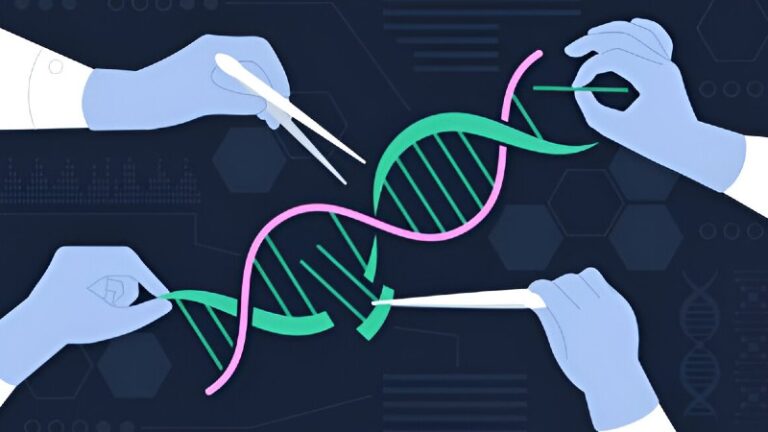Yet the future of genetic engineering is bigger than CRISPR itself. It includes editing without cutting, reversible epigenetic control, miniaturized editors for easier delivery, and integrated platforms that stitch diagnostics, therapeutics, and sustainability into a single bio-driven economy.
From DNA Scissors to a Modular Platform
CRISPR began as molecular scissors, cutting DNA where a guide RNA directs the Cas enzyme. Today it functions more like a Swiss Army knife with interchangeable tools:
- Knockouts: Disrupt a gene to study function or disable a harmful product.
- Knock-ins: Insert or correct sequences via homology-directed repair (HDR).
- CRISPRa / CRISPRi: Activate or repress genes with dCas9 (catalytically dead Cas9) fused to activators or repressors—no DNA cuts required.
- Base editing: Convert single DNA letters (A↔G or C↔T) without double-strand breaks.
- Prime editing: Search-and-replace edits using a Cas nickase and a template-bearing guide.
- Epigenome editing: Rewire gene expression by modifying chromatin marks, potentially reversible and safer for complex diseases.
These modes shift CRISPR from a one-off edit to a programmable platform where the same targeting logic (guide RNA) drives different outcomes (cutting, writing, or switching).
What’s Working Now
Medicine (One-Time Treatments & Reversible Control)
CRISPR-based therapies have moved from proof-of-concept to the clinic. Early approvals for severe blood disorders illustrate a key advantage: a one-time intervention that durably changes biology. Parallel efforts are advancing:
- Rare monogenic diseases: Thousands of conditions linked to single mutations are candidates for base or prime editing.
- Cancer immunotherapy: Ex vivo CRISPR can optimize T cells for potency and safety, complementing CAR-T strategies.
- Epigenetic therapeutics: For disorders where misregulation not hard-coded mutations drives pathology, epigenome editing aims to reset expression without altering DNA sequence.
Agriculture (Climate-Ready, Nutritious, and Efficient)
CRISPR accelerates trait development from decades to years. Examples include drought-tolerant cereals, disease-resistant cacao, and non-browning produce that reduces food waste. Because many edits mimic naturally occurring variants, products may fit existing regulatory paths in some regions.
Sustainability & Industry (Biology as Infrastructure)
Engineered microbes can upgrade carbon into fuels, crack plastics into feedstocks, and boost fermentation yields. Gene-edited yeast strains are already tuning flavor profiles and productivity in beverages and bio-manufacturing—pointing toward a circular bioeconomy where waste becomes resource.
The Expanding Toolkit
| Technology | What It Does | Why It Matters | Illustrative Use Case |
|---|---|---|---|
| Base Editing | Single-letter changes without cutting both DNA strands. | Reduces indels; precise for point mutations. | Correct a pathogenic SNP causing a blood or liver disorder. |
| Prime Editing | “Search & replace” insertions, deletions, or swaps. | Broad edit scope with fewer breaks. | Fix small insertions/deletions underlying inherited blindness. |
| Epigenome Editors | Switch genes on/off via chromatin marks, not sequence. | Potentially reversible; suits polygenic disease. | Sustainably upregulate protective fetal hemoglobin or silence a toxic protein. |
| CasMINI & Compact Cas Systems | Smaller editors with easier delivery. | Fits into common vectors; enables in vivo use. | Direct delivery to muscle or retina with AAV. |
| RNA-Targeting CRISPR (e.g., Cas13) | Binds/cleaves RNA rather than DNA. | Programmable antivirals; transient control. | Knock down viral RNAs or toxic transcripts without genome edits. |
The Hard Part
Editing is easy in a Petri dish; the challenge is getting editors to the right cells safely and efficiently—and only those cells.
Delivery Vectors at a Glance
| Vector | Typical Capacity | Strengths | Trade-offs |
|---|---|---|---|
| AAV (Adeno-Associated Virus) | ~4.7 kb | Well-characterized; tissue-tropic serotypes. | Limited cargo; pre-existing immunity; dose concerns. |
| Lipid Nanoparticles (LNPs) | N/A (RNP/mRNA payloads) | Non-viral; scalable; transient expression. | Organ targeting bias (e.g., liver); formulation complexity. |
| Lentiviral Vectors | ~8–9 kb | Stable integration; ex vivo cell engineering. | Insertional risk; less suited to in vivo systemic use. |
| Direct RNP Delivery | Protein + guide RNA | Immediate action; limited off-target window. | Uptake challenges; often ex vivo. |
Engineering for Specificity
- Guide RNA design algorithms: Balance on-target efficiency with off-target minimization using genome-wide scoring.
- High-fidelity Cas variants: Altered enzyme surfaces reduce promiscuous binding.
- Short exposure windows: Delivering Cas9 as protein–RNA complexes limits time to miscut.
- Orthogonal nucleases: Smaller or alternative Cas families improve targeting ranges and PAM flexibility.
CRISPR as a Universal Biological Platform
Most narratives treat CRISPR as a collection of tools. A more useful view is CRISPR as a platform layer like an operating system for biology on top of which diagnostics, therapies, and bio-manufacturing applications run. The common API is sequence complementarity (guide RNAs). The hardware is delivery. The apps are editors, switches, and sensors.
Three Platform Stacks Emerging
- Care Stack: Point-of-need diagnostics → patient stratification → ex vivo or in vivo editing → longitudinal epigenetic tuning for relapse prevention.
- Food Stack: Edited crops → soil and gut microbiome engineering → waste-to-value fermentation closing nutrient loops.
- Carbon Stack: CO2/plastic upcycling microbes → gene-edited algae for fuels/feeds → genetic containment and kill-switch governance.
Thinking in stacks clarifies where standards, safety guardrails, and business models must mature to scale responsibly.
Examples That Point to the Near Future
- Sickle cell and beta thalassemia: Early CRISPR therapies act once, then persist—rewriting the treatment paradigm for severe hemoglobinopathies.
- Inherited retinal disease: In vivo delivery to the eye is paving paths for local, precise interventions where systemic exposure is minimized.
- Microbial bioreactors: Edited yeast producing higher-value chemicals reduce energy use and waste in manufacturing.
- Food waste reduction: Non-browning produce and disease-resistant crops cut losses across the supply chain.
Policy, Ethics, and Public Trust
Powerful tools demand careful governance. Key principles:
- Do no harm: Clear separation between therapeutic use and enhancement; continued prohibition of “designer babies.”
- Reversibility and containment: Gene drives and ecological edits should include kill-switches or reversal mechanisms.
- Equity: Streamlined manufacturing and delivery innovations (e.g., smaller editors, standardized LNPs) must lower costs and widen access.
- Transparency: Public reporting of trial outcomes, adverse events, and off-target data builds trust.
Key Numbers at a Glance
- 100+ active/announced CRISPR-related clinical trials globally (spanning blood, eye, liver, and oncology indications).
- The CRISPR tools and services market is projected to reach $10B+ by 2030, driven by therapies, agriculture, and industrial biotech.
- 8,000+ rare diseases are linked to single-gene mutations—prime candidates for precision editing.
Note: Figures are rounded estimates to convey scale; specifics vary by methodology and reporting year.
How Organizations Can Prepare
- Define the problem precisely: Mutation-driven vs. expression-driven disease? Single-gene vs. polygenic? This dictates editing vs. epigenetic control.
- Choose the minimal effective modality: Prefer base/prime editing or epigenetic switching before full double-strand breaks when feasible.
- Design for delivery first: Match editor size and duration to vector constraints (AAV vs. LNP vs. ex vivo).
- Harden specificity: Use validated guide design, high-fidelity nucleases, and transient exposure strategies.
- Plan reversibility and monitoring: Track on-target durability and off-target signals with predefined rollback options where possible.
Conclusion
The future of genetic engineering goes well beyond traditional CRISPR cuts. With base and prime editing, epigenetic switches, compact nucleases, and robust delivery systems, biology is entering a programmable era. The most powerful shift is conceptual: CRISPR as a platform that coordinates diagnostics, therapeutics, and biomanufacturing accelerating discovery while embedding safety, equity, and reversibility.
If the last decade proved we can edit the genome, the next will show we can operate it responsibly at scale. The genome is no longer just read-only code; it is becoming designable software for human health, resilient food systems, and a cleaner planet.
Frequently Asked Questions (FAQs)
What is CRISPR and how does it work?
CRISPR is a gene-editing tool derived from a microbial immune system. It uses a guide RNA to target specific DNA sequences, allowing enzymes like Cas9 to cut or modify the genome precisely.
What are the main applications of CRISPR?
CRISPR is used in medicine for gene therapy, in agriculture for crop improvement, in sustainability for bio-manufacturing and carbon recycling, and in research for studying gene function.
What is the difference between base editing and prime editing?
Base editing allows conversion of a single DNA nucleotide without cutting both DNA strands, while prime editing acts as a ‘search-and-replace’ tool, inserting, deleting, or swapping DNA sequences with high precision.
What are epigenome editing and its advantages?
Epigenome editing modifies gene expression without changing the DNA sequence. It is potentially reversible, safer for complex diseases, and can silence toxic genes or upregulate protective proteins.
What are the challenges of CRISPR technology?
Key challenges include delivery to target cells, off-target effects, immune responses, high costs, and ethical concerns related to germline editing or ecological interventions.
What does the future of genetic engineering look like beyond CRISPR?
The future includes miniaturized editors like CasMINI, programmable epigenetic switches, RNA-targeting CRISPR systems, and integration into a universal platform linking diagnostics, therapeutics, and sustainable bio-manufacturing.


